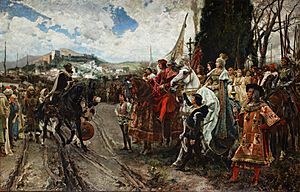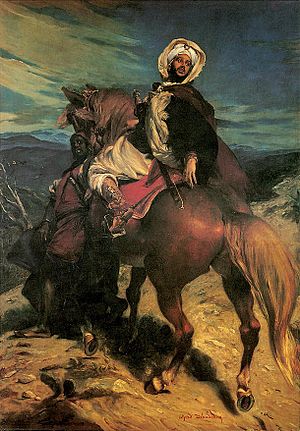Muhammad XII of Granada facts for kids
Quick facts for kids Muhammad XII |
|||||
|---|---|---|---|---|---|
| Sultan | |||||

An engraving of Muhammad XII. The date of this painting and its current location are unknown.
|
|||||
| Sultan of Granada 1st reign |
|||||
| Reign | 1482–1483 | ||||
| Predecessor | Abu l-Hasan Ali | ||||
| Successor | Abu l-Hasan Ali | ||||
| 2nd reign | |||||
| Reign | 1487 – 2 January 1492 | ||||
| Predecessor | Muhammad XIII | ||||
| Successor | None | ||||
| Born | c. 1460 Alhambra, Granada |
||||
| Died | 1533 (aged 72–73) Fes, Kingdom of Fez |
||||
| Consort | Morayma | ||||
| Issue | Ahmed Aixa (Sor Isabel de Granada) Yusef |
||||
|
|||||
| House | Nasrid dynasty | ||||
| Father | Abu l-Hasan Ali, Sultan of Granada | ||||
| Mother | Aixa | ||||
| Religion | Islam | ||||
Abu Abdallah Muhammad XII (Arabic: أبو عبد الله محمد الثاني عشر, romanized: Abū ʿAbdi-llāh Muḥammad ath-thānī ʿashar), born around 1460 and died in 1533, was the 22nd and last ruler of the Nasrid dynasty. He was the Sultan of the Emirate of Granada, a Muslim kingdom in what is now southern Spain. In Europe, he was widely known as Boabdil, which is a Spanish version of his Arabic name.
Contents
Becoming Sultan
Muhammad XII was the son of Abu l-Hasan Ali, who was also a Sultan of Granada. Muhammad XII became Sultan in 1482. This happened because of disagreements within the royal court and general unrest among the people.
Soon after becoming Sultan, Muhammad XII tried to gain more power and respect by attacking Castile, a Christian kingdom. However, he was captured in 1483 during a battle near Lucena. While he was a prisoner, his father was put back on the throne of Granada. Later, in 1485, his uncle Muhammad XIII (also known as Abdullah ez Zagal) became the ruler.
Muhammad XII was set free in 1487. He got help from the Christian rulers to get his throne back. In return, he agreed that Granada would become a kingdom that paid taxes to the Catholic monarchs. He also promised not to interfere when the Christians attacked Málaga in 1487.
After Málaga fell, other cities like Baza, Almuñécar, Salobreña, and Almería were taken by the Christians by 1488. By early 1491, Granada was the only Muslim-controlled city left in Iberia.
Surrender of Granada
In 1491, Isabella I of Castile and Ferdinand II of Aragon (the Catholic Monarchs) demanded that Muhammad XII surrender the city of Granada. The city was surrounded by Christian forces. Finally, on January 2, 1492, Granada was officially surrendered under the terms of the Treaty of Granada.

A person who saw the event wrote a letter describing it. The letter said that Muhammad XII, with about 80 to 100 horsemen, rode out to meet the Christian rulers. He was supposed to kiss their hands, but his strong-willed mother, Aixa, insisted that he be spared this final humiliation. So, the key to Granada was handed over without him having to kiss their hands.
Christopher Columbus was also there and wrote about the surrender. He mentioned seeing the royal flags of the Christian rulers raised on the towers of the Alhambra on January 2, 1492.
Life in Exile
As Muhammad XII left Granada for exile, a famous story says he stopped at a high point. From there, he took one last look at the city and the beautiful valley below. This spot is now called the Suspiro del Moro, which means "the Moor's sigh." Legend says he cried, and his mother told him, "Cry like a woman over what you couldn't defend like a man."
Muhammad XII was given land in Laujar de Andarax, a mountainous area. In October 1493, he left Spain from Adra and sailed to Cazaza in North Africa. He then settled in Fes, a city in what is now Morocco. He was joined by many of his courtiers and servants, about 1,130 people. Many other Muslims from Granada also moved to North Africa, as the surrender agreement allowed them to leave freely.
Letter to the Marinid Sultan
Soon after surrendering Granada, Muhammad Boabdil wrote a long letter to the Marinid rulers of Morocco. He asked for a safe place to live. In his letter, he praised the Marinids and expressed sadness about his defeat. He also asked for forgiveness for any past wrongs his ancestors might have done against them.
He wrote that the Christian ruler of Castile offered him a good place to live and promised safety. However, as a descendant of the Banu al-Ahmar, he felt he could not live under Christian rule. He also mentioned receiving invitations from rulers in the east, but he chose to go to his relatives, the Marinids. He believed it was important to follow the wishes of his ancestors, who said to only seek help from the Marinids.
Death in North Africa
The historian Al-Maqqari wrote in the 17th century that Muhammad XII crossed the Mediterranean Sea to Melilla and then went to Fes. He built a palace there and lived until his death in 1533 or 1534. He is believed to be buried near a special prayer area outside Bab Mahrouk in Fes. Muhammad XII had two sons, Yusef and Ahmed. Al-Maqqari met his descendants in F1618, and they were living in poverty.
Another idea about his death comes from a 19th-century scholar, M.C. Brosselard. He found an inscription on a stone slab in Tlemcen that suggested Muhammad XII died there in May 1494, at age 34. There might be some confusion about the exact place and date of his death, possibly because his uncle El Zagal also died in exile in North Africa.
A Spanish writer, Luis del Mármol Carvajal, stated that Muhammad XII died near the Oued el Assouad (Black River) during a war between the Marinids and the Saadians. This information was also used by Louis de Chénier, a French diplomat, in his book published in 1787.
See also
 In Spanish: Boabdil para niños
In Spanish: Boabdil para niños
- Al Andalus
- Alhambra Decree
- Reconquista
- Treaty of Granada


